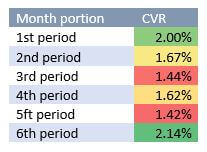11 ways to drop PPC spend and minimally affect performance
Most larger businesses will have a monthly marketing budget that gets shared out between all their advertising channels. This budget will often change month to month depending on how profitable the business thinks each month will be.

This results in a challenge for PPC account managers running Paid Search campaigns on Google Ads. We’re faced with constantly changing monthly budgets. If you’re faced with the prospect of dropping spend but want to negatively impact conversions as little as possible, then there are some solutions that you could try. The actual method (or combination of methods) that you use to drop spend will depend on the state of your account and your individual goals, but here are eleven things that you could try to drop spend on your PPC account:
1. Pause keywords
Perhaps the easiest thing to do is to pause keywords, ad groups or campaigns to bring down spend. If there are any campaigns, ad groups or keywords that are performing particularly poorly, then you could decide to pause these. If you choose to pause a campaign, then you will benefit from the spend reductions that come from that. If you choose to pause an ad group or keyword, then if you will need to also drop the budget of that campaign to ensure that you spend less.
To start pausing keywords or ad groups, you could start by cutting out high spending, non-converting keywords or ad groups. Or you could look at pausing keywords that are converting at a CPA or ROAS that is far too high.
2. Drop bids
Another simple approach is to just drop bids. Dropping bids will either reduce your impression share meaning your ads appear less often, drop the position of your ads in comparison to other paid ads, or a combination of both.
This will result in less traffic being generated by PPC, but it will also mean that each click that you get will cost less than it would have cost when your bids were higher. So, while this will reduce traffic and bring down spend, the fact that your clicks are now cheaper means that you should be getting fewer conversions but at a better CPA or ROAS.
One approach is to blanket drop bids on all your keywords, but this will mean dropping spend on strong performing keywords as well as poor performing keywords. A better course of action is to identify the poorest performing keywords in your account and drop bids on them.
3. Reduce spend on upper-funnel keywords
Keywords that users are likely to search when they are early on in their conversion journey are upper funnel keywords. These keywords can be beneficial to build brand awareness and lead customers down the funnel, eventually resulting in a lead or sale. However, these keywords are not going to be as profitable as lower funnel keywords. If you’re struggling to cut spend, then you could reduce spend on your upper funnel keywords. This will ensure that your strongest performing lower funnel keywords are still able to show on prominent positions.
Pausing upper funnel keywords can lead to a positive short-term performance improvement. However, if your upper funnel keywords were pushing people down the funnel and making people search for your lower funnel keywords, then by cutting out upper funnel keywords, you risk cutting out searches of your lower funnel keywords. If you decide to reduce spend on upper-funnel keywords, then keep an eye on conversions. If you notice that your lower funnel keywords start to drop in conversions, then this may be because you have cut spend too much on your upper funnel keywords.
4. Bid to a lower CPA or ROAS target
If you have a Cost Per Acquisition (CPA) or Return On Ad Spend (ROAS) target that you work towards, then try targeting a less aggressive CPA or ROAS. This will mean that you don’t drop bids on keywords that are already bringing in conversions at a lower CPA or ROAS than what you’re targeting, and you’ll only cut back on keywords that aren’t as profitable to you.
This solution is good if the vast amount of your keywords have a very high search top impression share and you don’t mind dropping their position on the page a little. If your keywords have a low search impression share, then by dropping bids, you risk putting your keywords in a position on the page where they are not likely to get many clicks.
5. Poor performing Dimensions
One of the things I like most about PPC and Google Ads is the vast amounts of targeting options and ways to segment data in order to find the best and worst-performing aspects of an account. It is worthwhile looking at whether a gender or age group performs better or worse on your account. If there is a dimension that is performing much worse than the other areas, then you could consider either blocking out that dimension or applying a bid reduction on it. This will help to reduce spend in an area that wasn’t performing very well.
To look at the performance of your campaigns by age group or gender, click on ‘Demographics’ and then select ‘Age’ or ‘Gender’ depending on the demographic that you want to look at. For advertisers in the USA, you can also look at performance by household income.
6. Search Partners and display Select
Look at the performance of Search Partners and Display Select. If you’re running one of these two options and the performance is worse than the search network, then you could consider switching them off. By switching Search Partners or Display Select off, you can bring down spend without affecting your performance on the Search Network.
To look at the performance of Search Partners and Display Select, click on Segments while in the campaign view of Google Ads and then click on ‘Network (with Search Partners)’. You can now see how Search Partners and Display Select perform in comparison to the Google Search Network.
7. Look at the portion of the month
I often see that the performance of many of my PPC accounts varies depending on the portion of the month. For example, I often see that conversion rates increase near the end and start of the month. While this doesn’t apply to all niches, it is probably because most people get paid near the end of the month and therefore can afford to buy more things during this period. It is worthwhile splitting out the performance of your Google PPC account into periods in the month. You can then look at conversions rates during the period of the month and make a strategy on what days you’re going to bid aggressively as well as the days when you’re going to reduce your budget.

8. Ad scheduling
From changing bid aggression based on the time of the month to bid adjustments based on the time of the day or day of the week. Are there any times of the day or days in the week that perform particularly poorly? If there are, then rather than blanket dropping bids, you could consider applying a bid reduction on your poorest performing hours or days
For example, many niches see a reduction in conversion rate past midnight until around 6 am in the morning. If this also applies in your niche, then you could try applying a bid reduction or switching off during these hours. Another example is a branch that sees the best performance during office hours. They could bring down spend by applying a bid reduction on times when their office is closed. It is important to monitor performance as you may find that you switch off PPC during hours when your customers are researching. This in turn could lead to fewer sales or leads during your best-performing times. Make sure you are utilising a conversion attribution option that gives credit to multiple touchpoints. This will reduce the chances of reducing bids during research times.
9. Location targeting
Look at the location performance and find areas that perform very poorly. You can either block these locations out or you can apply a bid reduction on them to reduce spend.
Make sure you only make decisions on locations that have enough data. Otherwise, you may end up blocking out or applying a bid reduction on a low-volume area that would have performed profitably.
10. Give some traffic to organic
Look for keywords that you rank number one for organically and that don’t have any paid competition. If you were to stop paid activity on these keywords, then there is a high chance that this traffic would still find its way to your site via your organic listing. If done well, you’ll be able to reduce your spend without sacrificing any traffic or sales/leads.
Just make sure that the person you’re answerable to is aware of this as you’re likely to see a reduction in traffic and conversions whilst organic sees the opposite. This will mean you don’t have questions to answer when your next PPC report appears to show a reduction in performance whilst the SEO team is reporting amazing figures.
There is an argument to suggest that some users may get distracted by the listings below your position one organic listing and that having an extra listing in the form of a PPC ad minimises the likelihood of this happening. So if you do decide to pause any keywords and give the traffic to your organic listings, then make sure you keep an eye on your reports to ensure that the traffic is still making its way to your site via an organic listing.
11. Inspect high volume non-exact match keywords
If you have a lot of non-exact match keywords in your account that have a lot of volume and are converting quite well, then this may be a good time to start dealing with them.
You could look at the traffic that is coming through these non-exact match keywords and start blocking out poor performing words or searches. Removing irrelevant or poor-performing searches will help to bring down spend. If done well, it won’t hurt conversions at all but it will bring your spend down.
Another tactic would be to segment out the strong performing, high volume keyword themes from a broad keyword and then either pause or reduce aggression on the broad keyword. This will mean that you reduce spend on your broad keyword whilst still maintaining the strong performing traffic that it was bringing in. Depending on how many high-volume broad keywords you have in the account, this can be a time-consuming task. Using this tactic to reduce spend, will depend on how much time you have available.
Wrapping up
PPC budgets can change every month for some businesses. If you need to drop PPC spend for whatever reason, then the above tactics should help. The exact method or combination of methods you use will depend on how much you need to drop spend by, and the state of your account at the time of dropping spend.